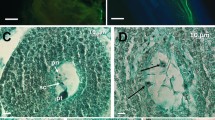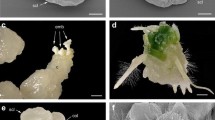Abstract
The wild tomato relative Solanum sitiens is a rare endemic plant of the Atacama Desert of Chile. This species exhibits unique traits—tolerance to drought, salinity and low temperatures, resistances to certain pathogens, and modified fruit ripening—that could be of interest to tomato breeders. However, strong reproductive barriers, including hybrid inviability, sterility, and unilateral incompatibility (UI), prevent or impede introgression with cultivated tomato. Using embryo culture, we obtained a large number of F1 S. lycopersicum × S. sitiens hybrids, and evaluated their fertility and compatibility as male or female parents. Diploid hybrids were functionally male-sterile and strongly rejected pollen of S. lycopersicum by UI. Chromosome doubling produced fertile allotetraploids, from which allotriploids (two genomes of S. lycopersicum, one of S. sitiens) were derived by crossing to diploid tomato. Rejection of tomato pollen occurred lower in styles of allotriploid than diploid hybrids. The pollen compatibility factors ui1.1 and ui6.1 were not sufficient for compatibility on S. sitiens allotriploid hybrids, unlike comparable hybrids with S. lycopersicoides. Pollen from F1 S. lycopersicum × S. pennellii was used to overcome UI on pistils of diploid S. lycopersicum × S. sitiens hybrids. This cross yielded progeny that were fertile and compatible in direct backcrosses to S. lycopersicum. These results establish a feasible method for transferring the S. sitiens genome into cultivated tomato.






Similar content being viewed by others
References
Albrecht E, Escobar M, Chetelat RT (2010) Genetic diversity and population structure in the tomato-like nightshades Solanum lycopersicoides and S. sitiens. Ann Bot 105:535–554
Baek YS, Covey PA, Petersen JJ, Chetelat RT, McClure B, Bedinger P (2015) Testing the ‘SI × SC rule’: pollen-pistil interactions in interspecific crosses between members of the tomato clade (Solanum section Lycopersicon, Solanaceae). Am J Bot 102:1–10
Canady MA, Ji Y, Chetelat RT (2006) Homeologous recombination in Solanum lycopersicoides introgression lines of cultivated tomato. Genetics 174:1775–1788
Canady MA, Meglic V, Chetelat RT (2005) A library of Solanum lycopersicoides introgression lines in cultivated tomato. Genome 48:685–697
Chetelat RT, Cisneros P, Stamova L, Rick CM (1997) A male-fertile Lycopersicon esculentum x Solanum lycopersicoides hybrid enables direct backcrossing to tomato at the diploid level. Euphytica 95:99–108
Chetelat RT, Pertuze RA, Faundez L, Graham EB, Jones CM (2009) Distribution, ecology and reproductive biology of wild tomatoes and related nightshades from the Atacama Desert region of northern Chile. Euphytica 167:77–93
Chetelat RT, Rick CM, Cisneros P, Alpert KB, DeVerna, JW (1998) Identification, transmission, and cytological behavior of Solanum lycopersicoides Dun. monosomic alien addition lines in tomato (Lycopersicon esculentum Mill.). Genome 41:40–50
Covey P, Kondo K, Welch L, Frank E, Sianta S, Kumar A, Nuez R, Lopez-Casado G, van der Knaap E, Rose J, McClure B, Bedinger P (2010) Multiple features that distinguish unilateral incongruity and self-incompatibility in the tomato clade. Plant J 64:367–378
DeVerna JW, Rick CM, Chetelat RT, Lanini BJ, Alpert KB (1990) Sexual hybridization of Lycopersicon esculentum and Solanum rickii by means of a sesquidiploid bridging hybrid. Proc Natl Acad Sci USA 87:9490–9496
Gardner RG (1992) ‘Mountain Spring’ tomato; NC 8276 and NC 84173 tomato breeding lines. J Am Soc Hortic Sci 27:1233–1234
Hanna GC, Gentile A, Smith PG, Lippert LF, Davis GN, McCoy OD (1964) Recently developed vegetable varieties. Calif Agric 18(3):8–10
Hardon JJ (1967) Unilateral incompatibility between Solanum pennellii and Lycopersicon esculentum Mill. Genetics 57:795–808
Houston J (2006) Variability of precipitation in the Atacama desert: its causes and hydrological impact. Int J Climatol 26:2181–2198
Ji Y, Pertuze RA, Chetelat RT (2004) Genome differentiation by GISH in interspecific and intergeneric hybrids of tomato and related nightshades. Chrom Res 12:107–116
Jones CM, Rick CM, Adams D, Jernstedt J, Chetelat RT (2007) Genealogy and fine mapping of obscuravenosa, a gene affecting the distribution of chloroplasts in leaf veins, and evidence of selection during breeding of tomatoes (Lycopersicon esculentum; Solanaceae). Am J Bot 94:935–947
Khush GS, Rick CM (1963) Meiosis in hybrids between Lycopersicon esculentum and Solanum pennellii. Genetica 33:167–183
Li W, Chetelat RT (2010) A pollen factor linking inter- and intraspecific pollen rejection. Science 330:1827–1830
Li W, Chetelat RT (2014) The role of a pollen-expressed Cullin1 protein in gametophytic self-incompatibility in Solanum. Genetics 196:439–442
Li W, Chetelat RT (2015) Unilateral incompatibility gene ui1.1 encodes an S-locus F-box protein expressed in pollen of Solanum species. Proc Natl Acad Sci USA 112:4417–4422
Li W, Royer S, Chetelat RT (2010) Fine mapping of ui6.1, a gametophytic factor controlling pollen-side unilateral incompatibility in interspecific Solanum hybrids. Genetics 185:1069–1080
Martin FW (1959) Staining and observing pollen tubes in the style by means of fluorescence. Stain Technol 34:125–128
Moyle LC, Nakazato T (2010) Hybrid incompatibility “Snowballs” between Solanum species. Science 329:1521–1523
Neal CA, Topoleski LD (1983) Effects of the basal medium on growth of immature tomato embryos in vitro. J Am Soc Hortic Sci 108:434–438
O’Connell MA, Hanson MR (1986) Regeneration of somatic hybrid plants formed between Lycopersicon esuclentum and Solanum rickii. Theor Appl Genet 72:59–65
Peralta IE, Spooner DM, Knapp S (2008) Taxonomy of wild tomatoes and their relatives (Solanum sect. Lycopersicoides, sect. Juglandifolia, sect. Lycopersicon; Solanaceae). Syst Bot Monogr 84:1–186
Pertuze RA, Ji Y, Chetelat RT (2003) Transmission and recombination of homeologous Solanum sitiens chromosomes in tomato. Theor Appl Genet 107:1391–1401
Rick CM (1951) Hybrids between Lycopersicon esculentum Mill. and Solanum lycopersicoides Dun. Proc Natl Acad Sci USA 37:741–744
Rick CM (1979) Biosystematic studies in Lycopersicon and closely related species of Solanum. In: Hawkes JG, Lester RN, Skelding AD (eds) The biology and taxonomy of the Solanaceae. Academic Press, New York, pp 667–678
Rick CM (1988) Tomato-like nightshades: affinities, autecology, and breeders opportunities. Econ Bot 42:145–154
Rick CM, Chetelat RT, DeVerna JW (1988) Recombination in sesquidiploid hybrids of Lycopersicon esculentum × Solanum lycopersicoides and derivatives. Theor Appl Genet 76:647–655
Rick CM, DeVerna JW, Chetelat RT, Stevens MA (1986) Meiosis in sesquidiploid hybrids of Lycopersicon esculentum and Solanum lycopersicoides. Proc Natl Acad Sci USA 83:3580–3583
Sacks EJ, Gerhardt LM, Graham EB, Jacobs J, Thorrup TA, St Clair DA (1997) Variation among 41 genotypes of tomato (Lycopersicon esculentum Mill.) for crossability to L. p eruvianum (L.) Mill. Ann Bot (Lond) 80:469–477
Smith SD, Peralta IE (2002) Ecogeographic surveys as tools for analyzing potential reproductive isolating mechanisms: an example using Solanum juglandifolium Dunal, S. o chranthum Dunal, S. lycopersicoides Dunal, and S. sitiens I.M. Johnston. Taxon 51:341–349
Acknowledgments
The author thanks the C.M. Rick Tomato Genetics Resource Center for providing seed samples, and Dr. Ricardo Pertuzé and Luis Faundez from the Universidad de Chile for their assistance collecting S. sitiens from the native region. Dr. Diana Burkart-Waco and Dr. Dragomira Markova at UC Davis provided comments on the manuscript. Kim Carney at UC Davis produced allotetraploid hybrids by chromosome doubling. This research was supported by grants from the National Institute of Food and Agriculture, U.S. Department of Agriculture, award number 2013-67013-21131, and from the National Science Foundation, award number MCB 1127059.
Author information
Authors and Affiliations
Corresponding author
Rights and permissions
About this article
Cite this article
Chetelat, R.T. Overcoming sterility and unilateral incompatibility of Solanum lycopersicum × S. sitiens hybrids. Euphytica 207, 319–330 (2016). https://doi.org/10.1007/s10681-015-1543-8
Received:
Accepted:
Published:
Issue Date:
DOI: https://doi.org/10.1007/s10681-015-1543-8




